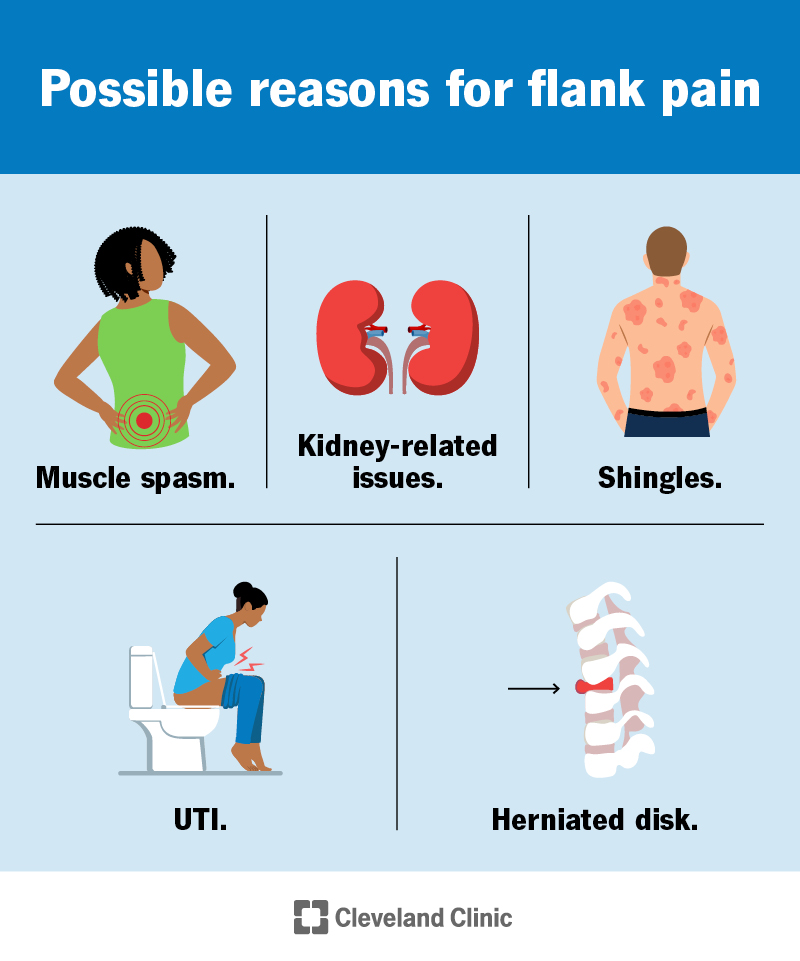Flank pain affects the area on either side of your lower back, between your pelvis and ribs. Flank pain may develop as a result of several conditions, diseases or injuries. Kidney stones, urinary tract infections and muscle strains are common causes of flank pain. Depending on the cause, flank pain treatment may include rest, medications or surgery.
Advertisement
Cleveland Clinic is a non-profit academic medical center. Advertising on our site helps support our mission. We do not endorse non-Cleveland Clinic products or services. Policy

Flank pain is pain in one or both sides of your abdomen. Certain injuries, diseases and infections can cause pain in your flanks.
Advertisement
Cleveland Clinic is a non-profit academic medical center. Advertising on our site helps support our mission. We do not endorse non-Cleveland Clinic products or services. Policy
Flank pain can range from mild to severe — it may be a dull ache or a sharp pain. It may come and go. It’s usually worse on one side. But it can occur on both flanks.
Your flanks are the areas on the sides and back of your abdomen, between your lower ribs and your hips.
Flank pain is very common. Most people get flank pain at some point in their lives. It’s usually not a cause for concern. But it’s a good idea to reach out to a healthcare provider if you have severe flank pain that lasts more than a few days.
Pain in your flanks usually means you sustained an injury or have a condition or disease. The most common causes of flank pain include:
Conditions that affect the following organs can cause flank pain:
Yes, muscle strains (pulled muscles) commonly cause flank pain. Strained back muscles may cause back pain, which can radiate away from your muscles and affect your flanks. Strained back muscles are common if you’re active in sports or work out a lot.
Advertisement
A healthcare provider will review your health history and perform a physical examination. They may ask questions like:
A provider may order several tests to help diagnose the cause of your flank pain. These tests may include:
Treatment depends on what’s causing your flank pain. A healthcare provider may recommend:
You can help relieve muscle pain in your flank with over-the-counter nonsteroidal anti-inflammatory drugs (NSAIDs) or prescription pain medicines (analgesics). Not everyone can take NSAIDs, so it’s a good idea to talk to a healthcare provider before taking any medications. If you have a history of kidney disease, you should avoid over-the-counter anti-inflammatory pain medications, including aspirin (Bayer®) ibuprofen (Advil®, Motrin®) and naproxen (Aleve®).
Stretching, exercise and physical therapy can also strengthen the muscles in your spine and help you avoid another injury.
You may not be able to prevent every cause of flank pain. But you can reduce your risk of kidney problems, injuries and diseases by:
Advertisement
Reach out to a healthcare provider if flank pain:
Flank pain that occurs along with other symptoms may be a sign of a serious health condition. Call a provider right away if you have flank pain and:
A muscle strain can cause flank pain. Your kidneys are usually below your ribcage, behind your belly. Most people have one on either side of your spine. You usually feel kidney pain on one side. A muscle strain that causes flank pain often worsens with certain movements, such as bending, twisting, lifting heavy weight, laughing or sneezing. Kidney pain doesn’t usually get worse with movements.
Flank pain that relates to your muscles and skeleton (musculoskeletal flank pain) usually feels more like a dull ache. It often worsens when you perform specific movements or apply pressure to the area.
Flank pain might feel be a mild ache or cramp, or it might be so severe that it makes you shake or vomit. As flank pain can be a symptom of many conditions and injuries, it’s important to pay attention to how the pain feels compared to what you’re used to. If it’s more severe — or doesn’t go away with rest or other at-home treatments — it’s time to contact a healthcare provider. And you should see someone even sooner if you have flank pain plus signs of an infection, like a fever or chills. Flank pain doesn’t always mean that there’s something serious going on, but getting medical attention means that you’ll be on your way to recovery sooner rather than later.
Advertisement
Need care fast? Cleveland Clinic’s Express Care and Urgent Care locations treat everything from sprains to sinus infections — no appointment needed.

Last reviewed on 02/22/2024.
Learn more about the Health Library and our editorial process.